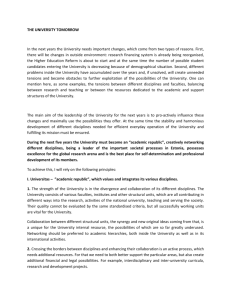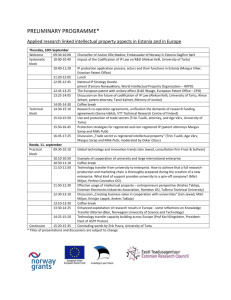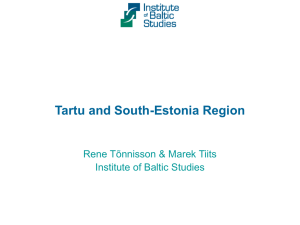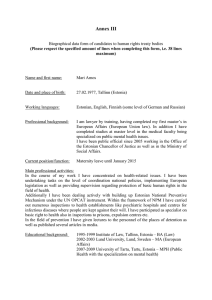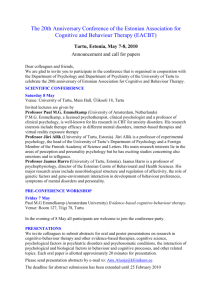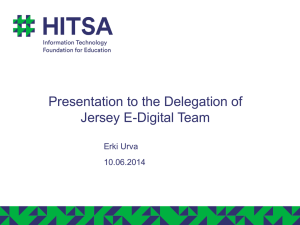Uploaded by
Rodger Lutalo
Big Data & Data Intensive Science: Infrastructure Challenges
advertisement
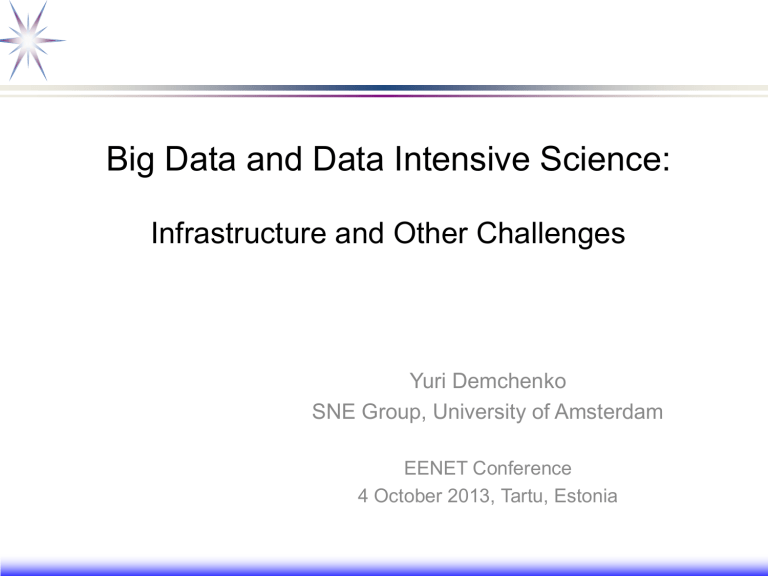
Big Data and Data Intensive Science: Infrastructure and Other Challenges Yuri Demchenko SNE Group, University of Amsterdam EENET Conference 4 October 2013, Tartu, Estonia Outline • Big Data and Data Intensive Science as a new technology wave – Big Data 5+1 Vs: Volume, Velocity, Variety, Value, Variability, Veracity • Big Data in Science, Industry and Business – Where do the data come from? What are Big Data drivers? • Big Data: Paradigm change and new challenges – From Big Data to All-Data – Moving to data centric service models • Defining Big Data Architecture Framework (BDAF) – Big Data Infrastructure (BDI) and Big Data Analytics tools • Addressing Big Data Infrastructure challenges by GEANT/NRENs – Horizon2020: e-Infrastructure challenges • Data Scientist: New profession and need for Education&Training • Summary and Discussion 4 October 2013, EENET, Tartu, Estonia Big Data and Infrastructure Challenges Slide_2 Big Data Research at System and Network Engineering (SNE), University of Amsterdam • Long time research and development on Infrastructure services and facilities – – – • Focus on Infrastructure definition and services – • Interest Group on Education and Skills Development on Data Intensive Science Big Data Interest Group at SNE, UvA – – • Active contribution on Reference Architecture, Big Data Definition and Taxonomy, Big Data Security Research Data Alliance – • Software Defined Infrastructure based on Cloud/Intercloud technologies NIST Big Data Working Group – • High speed optical networking and data intensive applications Application and infrastructure security services Collaborative systems, Grid, Clouds and currently Big Data Non-formal but active, meets two-weekly for brainstorming sessions Provides input to NIST BD-WG and RDA BoF on Big Data Challenges for NREN’s organised at TNC2013 https://tnc2013.terena.org/core/event/15 • SNE Technical Report on Architecture Framework and Components for the Big Data Ecosystem. Draft Version 0.2, 12 September 2013 http://www.uazone.org/demch/worksinprogress/sne-2013-02-techreport-bdaf-draft02.pdf 4 October 2013, EENET, Tartu, Estonia Big Data and Infrastructure Challenges 3 Visionaries and Drivers: Seminal works and High level reports The Fourth Paradigm: Data-Intensive Scientific Discovery. By Jim Gray, Microsoft, 2009. Edited by Tony Hey, et al. http://research.microsoft.com/en-us/collaboration/fourthparadigm/ Riding the wave: How Europe can gain from the rising tide of scientific data. Final report of the High Level Expert Group on Scientific Data. October 2010. http://cordis.europa.eu/fp7/ict/einfrastructure/docs/hlg-sdi-report.pdf https://www.rd-alliance.org/ AAA Study: Study on AAA Platforms For Scientific data/information Resources in Europe, TERENA, UvA, LIBER, UinvDeb. NIST Big Data Working Group (NBD-WG) https://www.rd-alliance.org/ 4 October 2013, EENET, Tartu, Estonia Big Data and Infrastructure Challenges 4 The Fourth Paradigm of Scientific Research 1. Theory and logical reasoning 2. Observation or Experiment – – E.g. Newton observed apples falling to design his theory of mechanics But Gallileo Galilei made experiments with falling objects from the Pisa leaning tower 3. Simulation of theory or model – Digital simulation can prove theory or model 4. Data-driven Scientific Discovery (aka Data Science) – More data beat hypnotized theory 4 October 2013, EENET, Tartu, Estonia Big Data and Infrastructure Challenges 5 Big Data and Data Intensive Science - The next technology focus Scientific and Research Data – e-Science • Big Data is/has becoming the next buzz word – Not much academic research and papers – Read seminal works, Dive into blogs and tweets • Based on e-Science concept and entire information and artifacts digitising – Requires also new information and semantic models for information structuring and presentation – Requires new research methods using large data sets and data mining • Methods to evolve and results to be improved • Changes the way how the modern research is done (in e-Science) – Secondary research, data re-focusing, linking data and publications • Big Data require a new infrastructure to support both distributed data (collection, storage, processing) and metadata/discovery services – High performance network and computing, distributed storage and access – Cloud Computing as native platform for distributed dynamic virtualised (data supporting) infrastructure – Demand for trusted/trustworthy infrastructure 4 October 2013, EENET, Tartu, Estonia Big Data and Infrastructure Challenges 6 Gartner Technology Hypercycle Big Data Cloud Computing Source http://www.gartner.com/technology/research/methodologies/hype-cycle.jsp 4 October 2013, EENET, Tartu, Estonia Big Data and Infrastructure Challenges 7 5 yr for Cloud Computing 2 yr for Big Data adoption 4 October 2013, EENET, Tartu, Estonia Big Data and Infrastructure Challenges 8 Technology Definitions and Timeline - Overview • Service Oriented Architecture (SOA): First proposed in 1996 and revived with the Web Services advent in 2001-2002 – Currently standard for industry, and widely used – Provided a conceptual basis for Web Services development • Computer Grids: Initially proposed in 1998 and finally shaped in 2003 with the Open Grid Services Architecture (OGSA) by Open Grid Forum (OGF) – Currently remains as a collaborative environment – Migrates to cloud and inter-cloud platform • Cloud Computing: Initially proposed in 2008 – Now entering productive phase – Defined new features, capabilities, operational/usage models and actually provided a guidance for the new technology development – Originated from the Service Computing domain and service management focused • Big Data and Data Intensive Science: Yet to be defined – Involves more components and processes to be included into the definition – Can be better defined as Ecosystem where data are the main driving component – Need to define the Big Data properties, expected technology capabilities and provide a guidance/vision for future technology development 4 October 2013, EENET, Tartu, Estonia Big Data and Infrastructure Challenges 9 Big Data Definitions Overview • IDC definition of Big Data (conservative and strict approach) : "A new generation of technologies and architectures designed to economically extract value from very large volumes of a wide variety of data by enabling high-velocity capture, discovery, and/or analysis“ • Gartner definition Big data is high-volume, high-velocity and high-variety information assets that demand costeffective, innovative forms of information processing for enhanced insight and decision making. http://www.gartner.com/it-glossary/big-data/ – • Big Data: a massive volume of both structured and unstructured data that is so large that it's difficult to process using traditional database and software techniques. – • From “The Big Data Long Tail” blog post by Jason Bloomberg (Jan 17, 2013). http://www.devx.com/blog/the-big-datalong-tail.html “Data that exceeds the processing capacity of conventional database systems. The data is too big, moves too fast, or doesn’t fit the structures of your database architectures. To gain value from this data, you must choose an alternative way to process it.” – • Termed as 3 parts definition, not 3V definition Ed Dumbill, program chair for the O’Reilly Strata Conference Termed as the Fourth Paradigm *) “The techniques and technologies for such data-intensive science are so different that it is worth distinguishing data-intensive science from computational science as a new, fourth paradigm for scientific exploration.” (Jim Gray, computer scientist) *) The Fourth Paradigm: Data-Intensive Scientific Discovery. Edited by Tony Hey, Stewart Tansley, and Kristin Tolle. Microsoft, 2009. 4 October 2013, EENET, Tartu, Estonia Big Data and Infrastructure Challenges 10 Improved: 5+1 V’s of Big Data Volume Variety • • • • • • Structured Unstructured Multi-factor Probabilistic Linked Dynamic • • • • Terabytes Records/Arch Tables, Files Distributed • • • • Batch Real/near-time Processes Streams 6 Vs of Big Data • Changing data • Changing model • Linkage Variability Velocity • • • • • Value • • • • Correlations Statistical Events Hypothetical Trustworthiness Authenticity Origin, Reputation Availability Accountability Generic Big Data Properties • Volume • Variety • Velocity Acquired Properties (after entering system) • Value • Veracity • Variability Commonly accepted 3V’s of Big Data Veracity 4 October 2013, EENET, Tartu, Estonia Big Data and Infrastructure Challenges 11 Big Data Definition: From 5+1V to 5 Parts (1) (1) Big Data Properties: 5V – Volume, Variety, Velocity, Value, Veracity – Additionally: Data Dynamicity (Variability) (2) New Data Models – Data Lifecycle and Variability – Data linking, provenance and referral integrity (3) New Analytics – Real-time/streaming analytics, interactive and machine learning analytics (4) New Infrastructure and Tools – – – – High performance Computing, Storage, Network Heterogeneous multi-provider services integration New Data Centric (multi-stakeholder) service models New Data Centric security models for trusted infrastructure and data processing and storage (5) Source and Target – High velocity/speed data capture from variety of sensors and data sources – Data delivery to different visualisation and actionable systems and consumers – Full digitised input and output, (ubiquitous) sensor networks, full digital control 4 October 2013, EENET, Tartu, Estonia Big Data and Infrastructure Challenges 12 Big Data Definition: From 5+1V to 5 Parts (1) (1) Big Data Properties: 5V – Volume, Variety, Velocity, Value, Veracity – Additionally: Data Dynamicity (Variability) (2) New Data Models – Data linking, provenance and referral integrity – Data Lifecycle and Variability/Evolution (3) New Analytics – Real-time/streaming analytics, interactive and machine learning analytics (4) New Infrastructure and Tools – – – – High performance Computing, Storage, Network Heterogeneous multi-provider services integration New Data Centric (multi-stakeholder) service models New Data Centric security models for trusted infrastructure and data processing and storage (5) Source and Target – High velocity/speed data capture from variety of sensors and data sources – Data delivery to different visualisation and actionable systems and consumers – Full digitised input and output, (ubiquitous) sensor networks, full digital control 4 October 2013, EENET, Tartu, Estonia Big Data and Infrastructure Challenges 13 Big Data Definition: From 5V to 5 Parts (2) Refining Gartner definition “Big data is (1) high-volume, high-velocity and high-variety information assets that demand (3) cost-effective, innovative forms of information processing for (5) enhanced insight and decision making” • Big Data (Data Intensive) Technologies are targeting to process (1) high-volume, high-velocity, high-variety data (sets/assets) to extract intended data value and ensure high-veracity of original data and obtained information that demand (3) cost-effective, innovative forms of data and information processing (analytics) for enhanced insight, decision making, and processes control; all of those demand (should be supported by) (2) new data models (supporting all data states and stages during the whole data lifecycle) and (4) new infrastructure services and tools that allows also obtaining (and processing data) from (5) a variety of sources (including sensor networks) and delivering data in a variety of forms to different data and information consumers and devices. (1) Big Data Properties: 5V (2) New Data Models (3) New Analytics (4) New Infrastructure and Tools (5) Source and Target 4 October 2013, EENET, Tartu, Estonia Big Data and Infrastructure Challenges 14 Big Data Origin • Science • Internet, Web • Industry • Business • Living Environment, Cities • Social media and networks • Healthcare • Telecom/Infrastructure 4 October 2013, EENET, Tartu, Estonia Data Transformation Big Data Nature: Origin and consumers (target) Big Data Target Use • Scientific discovery • New technologies • Manufacturing, processes, transport • Personal services, campaigns • Living environment support • Healthcare support • Social Networking Big Data and Infrastructure Challenges 15 Volume, Velocity, Variety – Examples e-Science • Volume – Terabyte records, transactions, tables, files. – LHC – 5 PB a month (now is under re-construction) – LOFAR, SKA – 5 PB every hour, requires processing asap to discard non-informative data – Large Synoptic Survey Telescope (LSST) - 10 Petabytes per year – Genomic research – x10 TB per individual – Earth, climate and weather data • Velocity – batch, near-time, real-time, streams. – LHC ATLAS detector generates about 1 Petabyte raw data per second, during the collision time about 1 ms • Variety – structures, unstructured, semi-structured, and all the above in a mix – Biodiversity, Biological and medical, facial research – Human, psychology and behavior research – History, archeology and artifacts 4 October 2013, EENET, Tartu, Estonia Big Data and Infrastructure Challenges 16 Volume, Velocity, Variety – Examples Industry • Volume – Terabyte records, transactions, tables, files. – A Boeing Jet engine produce out 10TB of operational data for every 30 minutes they run – Hence a 4-engine Jumbo jet can create 640TB on one Atlantic crossing. Multiply that to 25,000 flights flown each day • Velocity – batch, near-time, real-time, streams. – Today’s on-line ad serving requires 40ms to respond with a decision – Financial services (i.e., stock quotes feed) need near 1ms to calculate customer scoring probabilities – Stream data, such as movies, need to travel at high speed for proper rendering • Variety – structures, unstructured, semi-structured, and all the above in a mix – WalMart processes 1M customer transactions per hour and feeds information to a database estimated at 2.5PB (petabytes) – There are old and new data sources like RFID, sensors, mobile payments, in-vehicle tracking, etc. 4 October 2013, EENET, Tartu, Estonia Big Data and Infrastructure Challenges 17 The Long Tail of Science (aka “Dark Data”) • Collectively “Long Tail” science is generating a lot of data – Estimated as over 1PB per year and it is growing fast with the new technology proliferation • 80-20 rule: 20% users generate 80% data but not necessarily 80% knowledge Source: Dennis Gannon (Microsoft) 4 October 2013, EENET, Tartu, Estonia NIST Big Data Workshop, 2012 Big Data and Infrastructure Challenges 18 Big Data technology drivers (1) • Modern e-Science in search for new knowledge – Scientific experiments and tools are becoming bigger and heavily based on data processing and mining • Traditional data intensive industry – Genomic research, drugs development, Healthcare – High-tech industry, CAD/CAM, weather/climate, etc. • Intelligence and security • Network/infrastructure management – Network monitoring, Intrusion detection, troubleshooting 4 October 2013, EENET, Tartu, Estonia Big Data and Infrastructure Challenges 19 Big Data technology drivers – Technology Loop • Technology loop (known as Jevons Paradox) – Increased efficiency to process current demand will create new uses and increase demand even more Elastic Demand for Work: A doubling of fuel efficiency more than doubles work demanded, increasing the amount of fuel used. Jevons paradox occurs. 4 October 2013, EENET, Tartu, Estonia Big Data and Infrastructure Challenges 20 Big Data technology drivers (2) • Consumer facing companies like Google and Facebook have driven many of the recent advances in Big Data efficiency – Facebook has some 900+ million users and is still growing – Google handles number of search queries at 3 billion per day – Twitter handles some 400 million tweets per day count for 12 terabytes per day • Used also for market sentiments prediction – Power companies: process up to 350 billion annual meter readings to better predict power consumption • Processes/activity data recording and analysis – Flight data, log data, intelligence, traffic • Business (retail) uses Big Data technologies “to search” for customers – Modern business concept (multi-channel) of delivering directly to customers requires prediction of customer behavior • Data volumes – What cause(s) and what effect? – Big Data gives companies a fighting chance in the battle over the customer 4 October 2013, EENET, Tartu, Estonia Big Data and Infrastructure Challenges 21 Big Data technology drivers (3) - Advertising • “… this new course of big data, gleaned from a wealth of unstructured information on the web, has the ability to turn advertising on its head–– at least enough to make media people rethink algorithms for maximizing performance.” HessieJ.com – Traditional Ad Model: User profiles – More Sophisticated Ad Model: Behavioral targeting - "smart ads" – Future Ad Model: Enter Social Data • Example: – Mary Brown searches for information about a future trip to Mallorca • She also goes to travel sites, reads hotel reviews and has excitedly spoken to close friends on Twitter and Facebook about her plans and preparations – Now we have not only recent behavioral activity where she’s been on the internet, but we also are aware of her conversations that validate her behavior – It is safe to assume that Mary will “definitely” be going to Mallorca – What this information does for a travel company? • They now have MORE information on that user that will allow them to not only serve an ad, or even respond to that user with relevant offers, but DO so with a certain degree of confidence that Mary will at the very least click on the ad. 4 October 2013, EENET, Tartu, Estonia Big Data and Infrastructure Challenges 22 Big Data technology drivers (3a) – Service Delivery • Consumer products and services delivery – Netflix already captures movie genre preferences by the user and makes recommendations based on recent shows/movies watched • Announced $2mln prize for effective customer targeting in 2003 • Netflix recommender system in use as a reference technology implementation – It is already capturing which devices the user is watching recent programs/shows and when • Marrying that data with GetGlue (news feed on movies), for example, validates the original information and supplements the usage information – Combined and correlating, allows Netflix to optimize the movie offering to keep you a satisfied customer – It can also capture the comments and shares from those watching the movie in order to drive messaging to attract new users 4 October 2013, EENET, Tartu, Estonia Big Data and Infrastructure Challenges 23 Big Data technology drivers (3b) – Managing public campaigns, e.g. election, public relations • The rise of public opinion stored in platforms like Twitter, Google, Facebook, etc. provide enough intelligence to influence the campaign development, timing, geography and even the colour of the campaign signs – Twitter was a major source of data aggregation for the Republican Race in the US – Multimillion-dollar contract for data management and collection services awarded May 1, 2013 to Liberty Work to build advanced list of voters • Article “In Data we trust” by T.Edsall in The New York Times – Book: In Data We Trust: How Customer Data is Revolutionising Our Economy (Aug 2012) • A strategy for tomorrow's data world 4 October 2013, EENET, Tartu, Estonia Big Data and Infrastructure Challenges 24 Big Data technology drivers (4) - Emerging • Social media itself – share and socialise/collaborate – Facebook, Twitter, YouTube, Flickr, etc. • Workplace improvement – Means more data will be collected and monitored on the personnel • Healthcare, health/physiological and medical information – Human health monitoring – not just for ill or aged people • Early diagnostics, proactive care advising 4 October 2013, EENET, Tartu, Estonia Big Data and Infrastructure Challenges 25 http://mattturck.com/2012/10/15/a-chart-of-the-big-data-ecosystem-take-2/ 4 October 2013, EENET, Tartu, Estonia Big Data and Infrastructure Challenges 26 Foreseen Big Data Innovations in 2013+ • Cloud-Based Big Data Solutions – Amazon’s Elastic Map Reduce (EMR) is a market leader – Expected new innovative Big Data and Cloud solutions • Real-Time Hadoop – Google’s Dremel-like solutions that will allow real-time queries on Big Data and be open source • Distributed and deep Machine Learning – Mahout iterative scalable distributed back propagation machine learning and data mining algorithm – New algorithms Jubatus, HogWild • Big Data Appliances (also for home) – Raspberry Pi and home-made GPU clusters – Hardware vendors (Dell, HP, etc.) pack mobile ARM processors into server boxes – Adepteva's Parallella will put a 16-core supercomputer into range of $99 • Easier Big Data Tools – Open Source and easy to use drag-and-drop tools for Big Data Analytics to facilitate the BD adoption – Commercial examples: Radoop = RapidMiner + Mahout, Tableau, Datameer, etc. – LexisNexis: from ECL (Enterprise Control Language) to KEL (Knowledge Engineering Language) Source: Big Data in 2013 by Mike Guattieri, Forrester 4 October 2013, EENET, Tartu, Estonia Big Data and Infrastructure Challenges 27 NIST Big Data Working Group (NBD-WG) • Deliverables target – September 2013 – 26 September – initial draft documents – 30 September – Workshop and F2F meeting • Activities: Conference calls every day 17-19:00 (CET) by subgroup http://bigdatawg.nist.gov/home.php – – – – – Big Data Definition and Taxonomies Requirements (chair: Geoffrey Fox, Indiana Univ) Big Data Security Reference Architecture Technology Roadmap • BigdataWG mailing list and useful documents – Input documents http://bigdatawg.nist.gov/show_InputDoc2.php – Big Data Reference Architecture http://bigdatawg.nist.gov/_uploadfiles/M0226_v7_2611176301.docx – Big Data Architectures Survey http://bigdatawg.nist.gov/_uploadfiles/M0151_v2_7447424902.docx – Requirements for 51 usecases http://bigdatawg.nist.gov/_uploadfiles/M0224_v1_1076079077.xlsx 4 October 2013, EENET, Tartu, Estonia Big Data and Infrastructure Challenges 28 From Big Data to All-Data – Paradigm Change • Breaking paradigm changing factor – Data storage and processing – Security – Identification and provenance • Traditional model – BIG Storage and BIG Computer with FAT pipe – Move compute to data vs Move data to compute Move or not to move? Big Data Network ? Distributed Big Data Storage Data Abstraction Data Bus • New Paradigm – Continuous data production – Continuous data processing – DataBus as a Data container and Protocol 4 October 2013, EENET, Tartu, Estonia Big Computer Visuali sation Presen tation Action Infrastructure Abstraction Distributed Compute and Analytics Big Data and Infrastructure Challenges DataBus: (1) Data Container (2) Metadata, State (3) Data Transfer Protocol 29 Moving to Data-Centric Models and Technologies • Current IT and communication technologies are host based or host centric – Any communication or processing are bound to host/computer that runs software – Especially in security: all security models are host/client based • Big Data requires new data-centric models – Data location, search, access – Data integrity and identification – Data lifecycle and variability – Data centric (declarative) programming models – Data aware infrastructure to support new data formats and data centric programming models • Data centric security and access control 4 October 2013, EENET, Tartu, Estonia Big Data and Infrastructure Challenges 30 Defining Big Data Architecture Framework • Existing attempts don’t converge to something consistent: ODCA, TMF, NIST – See http://bigdatawg.nist.gov/_uploadfiles/M0151_v2_7447424902.docx • Architecture vs Ecosystem – Big Data undergo a number of transformations during their lifecycle – Big Data fuel the whole transformation chain • Data sources and data consumers, target data usage – Multi-dimensional relations between • Data models and data driven processes • Infrastructure components and data centric services • Architecture vs Architecture Framework – Separates concerns and factors • Control and Management functions, orthogonal factors – Architecture Framework components are inter-related 4 October 2013, EENET, Tartu, Estonia Big Data and Infrastructure Challenges 31 Big Data Architecture Framework (BDAF) (1) (1) Data Models, Structures, Types – Data formats, non/relational, file systems, etc. (2) Big Data Management – Big Data Lifecycle (Management) Model • Big Data transformation/staging – Provenance, Curation, Archiving (3) Big Data Analytics and Tools – Big Data Applications • Target use, presentation, visualisation (4) Big Data Infrastructure (BDI) – Storage, Compute, (High Performance Computing,) Network – Sensor network, target/actionable devices – Big Data Operational support (5) Big Data Security – Data security in-rest, in-move, trusted processing environments 4 October 2013, EENET, Tartu, Estonia Big Data and Infrastructure Challenges 32 Big Data Architecture Framework (BDAF) – Aggregated – Relations between components (2) Col: Used By Row: Requires This Data Models Structrs Data Models & Structures Data Managmnt & Lifecycle BigData Infrastr & Operations BigData BigData Analytics & Security Applicatn + ++ + ++ ++ ++ ++ ++ +++ Data Managmnt & Lifecycle ++ BigData Infrastruct & Operations +++ +++ BigData Analytics & Applications ++ + ++ BigData Security +++ +++ +++ 4 October 2013, EENET, Tartu, Estonia Big Data and Infrastructure Challenges ++ + 33 Data Source Data Collection& Registration Data Filter/Enrich, Classification Data Analytics, Modeling, Prediction Data Delivery, Visualisation Consumer Big Data Ecosystem: Data, Transformation, Infrastructure Big Data Target/Customer: Actionable/Usable Data Target users, processes, objects, behavior, etc. Federated Access and Delivery Infrastructure (FADI) Big Data Source/Origin (sensor, experiment, logdata, behavioral data) Big Data Analytic/Tools Storage General Purpose Data Management Compute General Purpose High Performance Computer Clusters Storage Specialised Databases Archives (analytics DB, In memory, operstional) Data categories: metadata, (un)structured, (non)identifiable Data Datacategories: categories:metadata, metadata,(un)structured, (un)structured,(non)identifiable (non)identifiable Intercloud multi-provider heterogeneous Infrastructure Security Infrastructure 4 October 2013, EENET, Tartu, Estonia Network Infrastructure Internal Infrastructure Management/Monitoring Big Data and Infrastructure Challenges 34 General BDI services and components • Data management infrastructure and tools • Registries, search/indexing, ontologies, schemas, namespace • Collaborative Environment (user/groups managements) • Heterogeneous multi-provider Inter-cloud infrastructure – Compute, Storage, Network (provisioned on-demand dynamically scaling) – Federated Access and Delivery Infrastructure (FADI) • Advanced high performance (programmable) network • Security infrastructure (access control, Identity and policy management, confidentiality, privacy, trust) 4 October 2013, EENET, Tartu, Estonia Big Data and Infrastructure Challenges 35 Big Data Infrastructure and Analytic Tools Big Data Target/Customer: Actionable/Usable Data Target users, processes, objects, behavior, etc. Big Data Source/Origin (sensor, experiment, logdata, behavioral data) Big Data Analytic/Tools Analytics: Refinery, Linking, Fusion Analytics : Realtime, Interactive, Batch, Streaming Storage General Purpose Data Management Compute General Purpose Analytics Applications Link Analysis Cluster Analysis Entity Resolution Complex Analysis High Performance Computer Clusters : Federated Access and Delivery Infrastructure (FADI) Storage Specialised Databases Archives Data categories: metadata, (un)structured, (non)identifiable Data Datacategories: categories:metadata, metadata,(un)structured, (un)structured,(non)identifiable (non)identifiable Intercloud multi-provider heterogeneous Infrastructure Security Infrastructure 4 October 2013, EENET, Tartu, Estonia Network Infrastructure Internal Infrastructure Management/Monitoring Big Data and Infrastructure Challenges 36 Big Data Analytics Infrastructure • High Performance Computer Clusters (HPCC) • Specialised Storage, Distributed/Replicated, Archives, Databases, SQL/NoSQL • Big Data Analytics Tools/Applications • Analytics/processing: Real-time, Interactive, Batch, Streaming • Link Analysis, Graph analysis • Cluster Analysis • Entity Resolution • Complex Analysis 4 October 2013, EENET, Tartu, Estonia Big Data and Infrastructure Challenges 37 Data Transformation/Lifecycle Model Common Data Model? • Data Variety and Variability • Semantic Interoperability Data Model (1) Data Model (1) Data Model (4) Data (inter)linking? • Persistent ID • Identification • Privacy, Opacity Data Storage Data Collection& Registration Data Filter/Enrich, Classification Data Analytics, Modeling, Prediction Data Delivery, Visualisation Consumer Data Analitics Application Data Source Data Model (3) Data repurposing, Analitics re-factoring, Secondary processing • • Does Data Model changes along lifecycle or data evolution? Identifying and linking data – – – Traceability vs Opacity Referral integrity Persistent identifier 4 October 2013, EENET, Tartu, Estonia Big Data and Infrastructure Challenges 38 Evolutional/Hierarchical Data Model Actionable Data Papers/Reports Archival Data Usable Data Processed Data (for target use) Processed Data (for target use) Processed Data (for target use) Classified/Structured Data Classified/Structured Data Classified/Structured Data Raw Data • • • • Common Data Model? Data interlinking? Fits to Graph data type? Metadata 4 October 2013, EENET, Tartu, Estonia • • • • Referrals Control information Policy Data patterns Big Data and Infrastructure Challenges 39 Horizon2020: Challenge (2.1): Development, deployment and operation of e-infrastructures Call on Specific Challenge 2.1: Development, deployment and operation of einfrastructures (based on discussion draft summer 2013) CHALLENGE 1 – High Performance Computing (HPC) CHALLENGE 2 - CONNECTIVITY Topic 4: Research and Education Networking – GÉANT CHALLENGE 3 - DATA Topic 5: Community data services Topic 6: Managing, preserving and computing with big research data Topic 7: e-Infrastructure for Open Access Topic 8: Towards global data e-infrastructures - RDA CHALLENGE 4 – e-INFRASTRUCTURE INTEGRATION Topic 9: e-Infrastructures for virtual research environments (VRE) Topic 10: Provisioning of core services across e-Infrastructures Topic 11: Skills and new professions for e-infrastructures CHALLENGE 5 – POLICY AND INTERNATIONAL Topic 12: Policy development and international cooperation 4 October 2013, EENET, Tartu, Estonia Big Data and Infrastructure Challenges 40 GEANT and NRENs: Addressing Big Data Infrastructure Challenges • Open Cloud eXchange (OCX) initiative by GN3plus JRA1: Network Architectures for Horizon 2020 – GEANT Network to support 2Tbps capacity backbone – SURFnet – PSNC 100 Gbps remote robotics demo at TNC2013 • From Software Defined Network (SDN) to Software Defined Infrastructure (SDI) – A new thinking beyond current challenges • Federated Identity Management and Federated Access and Delivery Infrastructure (FADI) 4 October 2013, EENET, Tartu, Estonia Big Data and Infrastructure Challenges 41 General use case for infrastructure provisioning: Workflow => Logical (Cloud) Infrastructure Enterprise/Scientific workflow Storage Data Special Proc 1 Data Filtering Input Data Visual Present Special Proc 2 Instrum. Data Campus A Data Archive Visualisation Visualisation CE User Group A Campus B CE User User User User User User VR6 Cloud 2 PaaS VR2 VR7 VR4 VR1 VR5 Resource/ Service Provider Enterprise/Scientific workflow Is mapped to heterogeneous cloud infrastructure containing IaaS, PaaS components 4 October 2013, EENET, Tartu, Estonia User Group B VR3 Enterprise/Project based Intercloud Infrastructure Cloud 1 IaaS Resource/ Service Provider CN CN CN CN CN CN Cloud PaaS Provider CN CN CN CN CN Cloud IaaS Provider Big Data and Infrastructure Challenges 42 Multi/inter- cloud infrastructure provisioning: => ICADI and OCX functions Enterprise/Scientific workflow Campus A Storage Data Visualisation Visualisation Data Archive Data Filtering Input Data CE User Group A Special Proc 1 Visual Present CE Special Proc 2 Instrum. Data User User User User User User Campus B User Group B OCX as a part of GEANT infrastructure OCX at NREN OCX at NREN VR6 Cloud 2 PaaS VR2 VR7 VR4 VR1 Open Cloud eXchange (OCX) interconnects CSP and Customer (campus) infrastructures VR5 Resource/ Service Provider VR3 Cloud 1 IaaS Resource/ Service Provider CN CN OCX assumes collocation or collapsed backbone for connecting all OCX members 4 October 2013, EENET, Tartu, Estonia Enterprise/Project based Intercloud Infrastructure CN CN CN CN Cloud PaaS Provider CN CN CN CN CN Cloud IaaS Provider Big Data and Infrastructure Challenges 43 General use case for infrastructure provisioning: Logical Infrastructure => Network Infrastructure (2) Resource and Cloud Provider Domains VR3 VR1 VR5 VR7 Campus A Infrastructure Campus B Infrastructure VR2 VR4 OCX at Cloud Carrier or Network Provider (NREN) level Network Provider 1 Campus A Visualisation VR6 Visualisation Cloud Carrier or Network Provider 2 CE User Group A Campus B CE User User User User User User VR6 Cloud 2 PaaS VR2 VR7 VR4 VR1 VR5 Resource/ Service Provider Provisioning network infrastructure may involve multiple providers Introducing OCX (Open Cloud eXchange) 4 October 2013, EENET, Tartu, Estonia User Group B VR3 Enterprise/Project based Intercloud Infrastructure Cloud 1 IaaS Resource/ Service Provider CN CN CN CN CN CN Cloud PaaS Provider CN CN CN CN CN Cloud IaaS Provider Big Data and Infrastructure Challenges 44 OCX Definition and Operational Principles • Direct service/inter-member peering – Re-use and leverage Internet eXchange Point (IXP) experience – Open collocation services • No third party (intermediary/broker) services – Transparency for cloud based services – No involvement into peering or mutual business relations • Trusted Third Party (TTP) – To support dynamic service agreements and/or federation establishment – Trusted Introducer for dynamic trust establishment • May include other special services to support smooth services delivery and integration between CSP and Customer – E.g., Local policies, service registry and discovery, Application/VM repository 4 October 2013, EENET, Tartu, Estonia Big Data and Infrastructure Challenges 45 OCX Trusted Third Party services TTP OCX OCX L0-L2/L3 topology • Any-to-any • Distributed, collapsed, hierarchical • Topology information exchange L0L2 + L3? • QoS control • SDN control over OCX switching TTP goals and services • Enable dynamic federations establishment • Trusted Certificates and CA’s Repository – Similar to TACAR (TERENA Academic CA Repository) • Trusted Introducer Service – Trusted Introduction Protocol Pre-established trust relation with OCX as TTP • • Service Registry and Discovery SLA repository and clearinghouse Trust relations established as a part of dynamic federation between OCX members 4 October 2013, EENET, Tartu, Big Data and Infrastructure Challenges Estonia 46 OCX location options: GN3, NREN (+University?) GEANT CSP NREN University Visualisation VR6 CE VR7 DFlow OCX VR4 VR5 User User User VR3 IP/L3 L2 Visualisation VR6 CE VR7 L1 OCX VR4 User User User VR5 L0 VR3 4 October 2013, EENET, Tartu, Estonia Big Data and Infrastructure Challenges 47 OCX Hierarchical Topology Model GEANT CSP NREN University Visualisation VR6 CE VR7 OCX VR4 VR5 User User User VR3 DFlow IP/L3 L2 Visualisation VR6 CE VR7 L1 OCX VR4 User User User VR5 L0 VR3 4 October 2013, EENET, Tartu, Estonia Big Data and Infrastructure Challenges 48 Pilot OCX Concept Implementation by SURFnet • NetherLight as an Open Lightpath Exchanges (OLE) operated by SURFnet – To Bandwidth on Demand, Virtual Networking – 100G transatlantic trials, and – Open Cloud eXchange (OCX) pilot/prototype • Since 2012, SURFnet and NetherLight have been performing pilots with cloud providers that want to offer their services with lightpath characteristics to SURFnet connected institutions • GreenQloud (Iceland) offers service delivery over lightpaths via NetherLight/SURFnet with advantages above the regular IP services – – – – Guaranteed bandwidth and latency Protected from the external Internet Possibility of domain extension (VM’s appear as if inside campus network) Cost reduction due to offloading of traffic • Pilot since 2012 between OneXS and Windesheim University of Applied Sciences to deliver unified services of fixed and mobile telephony 4 October 2013, EENET, Tartu, Estonia Big Data and Infrastructure Challenges 49 General SURFnet Lightpath interconnection Universities • GeenQloud: cloud services • OneXS: unified services of fixed and mobile telephony 4 October 2013, EENET, Tartu, Estonia Big Data and Infrastructure Challenges 50 Data Scientist: New Profession and Opportunities McKinsey Institute on Big Data Jobs http://www.mckinsey.com/mgi/publications/big_data/index.asp • There will be a shortage of talent necessary for organizations to take advantage of Big Data. – – By 2018, the United States alone could face a shortage of 140,000 to 190,000 people with deep analytical skills as well as 1.5 million managers and analysts with the know-how to use the analysis of big data to make effective decisions SOURCE:US Bureau of Labor Statistics; US Census; Dun & Bradstreet; company interviews; McKinsey analysis 4 October 2013, EENET, Tartu, Estonia Big Data and Infrastructure Challenges 51 H2020 Topic 11 - Skills and new professions for e-Infrastructure research data • Scope of work of the emerging professions of – e-infrastructure developers, integrators, operators, research technologists, data scientists and data librarians • To support researchers, professors and students in – computing and networking, as well as in handling, analysing, and storing large amounts of data and content • Support the establishment of these professions as distinct professions from that of a researcher and a traditional computer specialist/engineer • Create a reference model and a Common Body of Knowledge (CBK) which defines their competencies • Defining or updating university curricula for the e-infrastructure competences mentioned above, and promoting their adoption – Development of appropriate curricula and training materials 4 October 2013, EENET, Tartu, Estonia Big Data and Infrastructure Challenges 52 Slide from the presentation Demystifying Data Science (by Natasha Balac, SDSC) 4 October 2013, EENET, Tartu, Estonia Big Data and Infrastructure Challenges 53 Strata Survey Skills and Data Scientist Self-ID Analysing the Analysers. O’Reilly Strata Survey – Harris, Murphy&Vaisman, 2013 • Based on how data scientists think about themselves and their work • Identified four Data Scientist clusters 4 October 2013, EENET, Tartu, Estonia Big Data and Infrastructure Challenges 54 Skills and Self-ID Top Factors Business ML/BigData Math/OR Programming Statistics ML – Machine Learning OR – Operations Research 4 October 2013, EENET, Tartu, Estonia Big Data and Infrastructure Challenges 55 Key to a Great Data Scientist Technical skills (Coding, Statistics, Math) + Commitment + Creativity + Intuition + Presentation Skills + Business Savvy = Great Data Scientist! • How Long Does It Take For a Beginner to Become a Good Data Scientist? – 3-5 years according to KDnuggets survey [278 votes total] 4 October 2013, EENET, Tartu, Estonia Big Data and Infrastructure Challenges 56 Inter-university coordination on new curricula • RDA Interest Group on Education and Skills development in Data Intensive Science • LERU (League of European Research Universities) position paper – November 2013 • LIBER/Libraries and data archives organisations • International cooperation Europe-USA-China – Pilot project on development of Data Intensive Computing course between University of Stavanger and Purdue University • University of Amsterdam Data Scientist curriculum to be steered by the Data Science Research Center 4 October 2013, EENET, Tartu, Estonia Big Data and Infrastructure Challenges 57 Summary and topics for discussion • Researching, learning mastering Big Data domain is a Big Data problem itself • Cloud Computing as a native platform for Big Data – Acceptance of clouds will grow, so demand for specialists • Demand for advanced high performance network will remain and grow – GEANT and NRENs have a lot to offer here • New generically data centric models are required • New distributed data processing and analytics computing models to be developed/re-factored • Data Scientist is a new focus for talents search by companies 4 October 2013, EENET, Tartu, Estonia Big Data and Infrastructure Challenges 58 Questions and Discussion 4 October 2013, EENET, Tartu, Estonia Big Data and Infrastructure Challenges 59 Useful links • SNE Technical Report on Architecture Framework and Components for the Big Data Ecosystem. Draft Version 0.2, 12 September 2013 http://www.uazone.org/demch/worksinprogress/sne-2013-02-techreport-bdaf-draft02.pdf • • Addressing Big Data Issues in Scientific Data Infrastructure. Paper published at IEEE CTS 2013 Conf., May 20-24, 2013, San Diego, USA http://www.uazone.org/demch/papers/bddac2013-bigdata-infrastructure-v06.pdf BoF on Big Data Challenges for NREN’s organised at TNC2013 https://tnc2013.terena.org/core/event/15 • NIST Big Data Working Group (NBD-WG) http://bigdatawg.nist.gov/home.php – Input documents http://bigdatawg.nist.gov/show_InputDoc2.php – Big Data Reference Architecture http://bigdatawg.nist.gov/_uploadfiles/M0226_v7_2611176301.docx – Big Data Architectures Survey http://bigdatawg.nist.gov/_uploadfiles/M0151_v2_7447424902.docx – Requirements for 51 usecases http://bigdatawg.nist.gov/_uploadfiles/M0224_v1_1076079077.xlsx 4 October 2013, EENET, Tartu, Estonia Big Data and Infrastructure Challenges 60 NIST Big Data Working Group (NBD-WG) • NIST Big Data Working Group (NBD-WG) http://bigdatawg.nist.gov/home.php • BigdataWG mailing list and useful documents – Input documents http://bigdatawg.nist.gov/show_InputDoc2.php – Big Data Reference Architecture http://bigdatawg.nist.gov/_uploadfiles/M0226_v7_2611176301. docx – Big Data Architectures Survey http://bigdatawg.nist.gov/_uploadfiles/M0151_v2_7447424902. docx – Requirements for 51 usecases http://bigdatawg.nist.gov/_uploadfiles/M0224_v1_1076079077. xlsx 4 October 2013, EENET, Tartu, Estonia Big Data and Infrastructure Challenges 61

